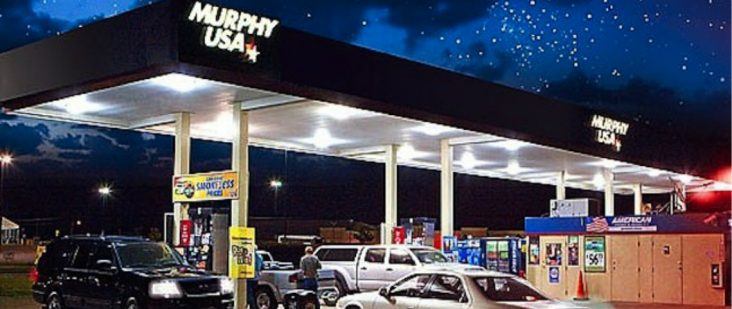NRF: Harps, Murphy USA among top 100 ‘hot retailers.’ Walmart not on the list
by August 14, 2018 3:31 pm 2,097 views

Two Arkansas-based retailers – Harps Foods of Springdale and Murphy USA of El Dorado – ranked among the nation’s fastest-growing retail companies by year-over-year domestic sales growth, according to the National Retail Federation annual report conducted by Kantar Consulting.
This year’s report notes “hot retailers” come in all shapes and sizes as nine of the top 10 businesses represent different retail segments.
Walmart, the nation’s largest retailer, didn’t make the top 100 cut though the Bentonville-based retailer had the most overall U.S. sales last year at $318.5 billion. The annual Walmart growth rate of 3.5% was below the 4% recorded by GameStop to round out the top 100.
Walmart competitor Amazon did make the list ranking fourth with U.S. growth rate of 45% between 2016 and 2017. Amazon’s acquisition of Whole Foods helped drive the revenue growth, according to Kantar analyst Laura Kennedy. Primark, with just 8 stores in the U.S., ranked first with a growth rate of 103% and total sales of $9.875 billion.
Bass Pro Shops, ranked No. 2 and recorded a 94% growth in sales that was aided by the acquisition of Cabela’s. Online retailer Build.com grew U.S. sales by 30% to $1.34 billion ranking it third on the list. Wayfair came in fifth with a 36% growth rate and revenue of $4.696 billion. Other retailers in the top 10 include: PetSmart /Chewy’s, up 28% to 8.6 billion; Five Below, up 28% to $1.28 billion; and Ulta, up 28% to $5.8 billion.
Economic and shopper dynamics contribute to the diversity among the ranks of the hottest retailers, said Sara Al-Tukhaim, a senior vice president of Kantar Consulting.
“Shoppers are feeling good about the economy. Job rates are at an all-time high. ‘Haves’ are expecting tax cuts to boost income growth,” Al-Tukhaim said. “All of this is translating to spending including home buying, and more discretionary spending such as home improvement projects, experiences, beauty and the like.”
Murphy USA which operates 288 convenience stores ranked 19th on the list with sales growth of 16% and annual revenue of $469 million. Other convenience stores to make the list include Casey’s General Stores growing sales by 6% to $3.243 billion and ranking No. 79. QuickTrip ranked No. 85 with sales of $1.483 billion, up 5% year-over-year.
Other grocery competitors to Walmart such as Aldi also made the list. At No 34 Aldi, which includes Trader Joe’s, operates 2,250 stores with total sales of $25.958 billion, up 26% from the prior year. At No. 45 Costco grew sales by 9% to $123.8 billion with 510 U.S. clubs.
Harps Food Stores continues to carve out its success while being located in Walmart’s backyard. Harps grew sales high enough to make list. At No. 78, Harps reported sales of $1.15 billion from the 92 stores it operates. Kroger came in at No. 81 with sales growth of 5% to $115.89 billion. Wegmans Food Market in the Northeast grew sales by 5% to $8.682 billion ranking it No. 98.
Off-price retailers such as Burlington Coat Factory and Ross also made the list with 9% sales growth. With 510 stores Burlington ranked No. 39 posting sales of $6.038 billion. At No. 41 Ross generated sales of $14 billion in its 1,620 stores. TJX Companies which includes TJ Maxx, Marshalls and HomeGoods, ranked No. 67 with 7% growth to $35.865 billion.
The Dollar-store chains varied in their growth rates with the 99 Cents Store ranking the highest in this category at No. 48. With 389 stores sales grew 8% to $2.191 billion. Dollar Tree grew sales by 7% to $22.246 billion, ranking No. 58. Dollar General also grew sales at 7% to $23.471 billion ranking No. 63.
Target, CVS and Walgreens also didn’t make the list, though there was some representation from drug-store cooperatives such as Care Pharmacy Cooperatives ranking No. 17 with a 17% growth rate, and Good Neighbor Pharmacy, No. 69 with a 6% growth rate and sales of $9.8 billion.
Kantar analyst Kate Senzamici said challenges in the drug-store sector continue as CVS and Walgreens have each struggled with foot traffic. She said drug retailers are experimenting with new initiatives aimed at ramping up fulfillment and delivering on the last mile in order to provide more holistic shopping options. Curbside pickup and same-day or two-day prescription delivery both factor into this. Longer term she expects drug retailers to emphasis lower costs and focus on expanded access to increasing volume in the Medicare Part D market.
